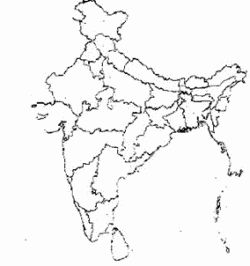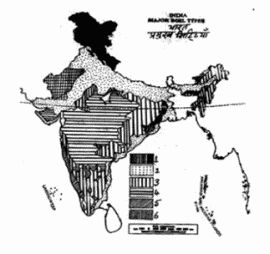
National Institute of Open Schooling (NIOS) | Class XI Sample Question Paper - Social Science (213)
Sample Question Paper
Social Science (213)
Time: 3 hours
Maximum Marks : 100
Note: (i) All questions are compulsory. Marks are indicated against each question.
1. In the given outline map of India mark and label the following: 2
i) A union Territory having the highest density of population.
ii) A metropolitan city having the largest population

2. Write in your answer book the correct names of the major soil types shown in the map by shades 2, 3, 4 and 6. 4

3. Which one of the following states has the highest proportion of urban population in its total population? 1
(a) Maharashtra
(b) U.P.
(c) Kerala
(d) Mizoram
4. The word “Democracy” has originated from which language? Select the correct alternative. 1
a) Latin
b) French
c) German
d) Greek
5. Which one of the following is the natural habitat of rhinoceros in India? 1
(a) Hot-wet forests of Kerala
(b) Desert areas of Rajasthan
(c) Arid areas of Rann of Kachchh
(d) Swampy lands of Assam
6. What was the real motive of the British in the Partition of Bengal in 1905? 1
(a) Administrative convenience
(b) Spreading nationalist feeling in Bengal
(c) Checking the occurrence of famines in Bengal
(d) To suppress the growth of nationalist feeling in Bengal
7. The reason for the failure of the League of Nation was that: 1
a) It had too many members
b) It had no administrative body
c) It had no constitution to define the powers of various organs
d) It had no army to enforce its decision
8. Which of the four cities situated on the bank of the Yamuna river is a holy city of the Hindus. 1
a. Delhi
b. Mathura
c. Agra
d. Hamirpur
9. How can the U.N. Security Council deal with an act of aggression against one of the U.N. members? 1
a) It may let the victim fight its own battle.
b) It may let the victim seek help of any big power
c) It may ask regional organisation to arrange the defence of the victim.
d) It may ask member countries to apply collective security measures of military sanctions.
10. Which one of the following is the first country in the world to have a national population policy? 1
(a) USA
(b) Russia
(c) India
(d) China